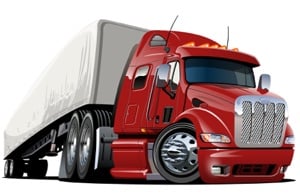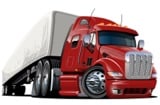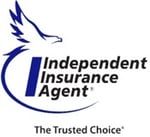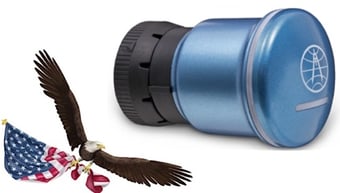 As you know, good drivers aren’t easy to come by, so keeping them as safe as possible on the road should be a top priority. Keeping your drivers safe has the added benefit of lowering Truck Insurance costs and other costs associated with accidents.
As you know, good drivers aren’t easy to come by, so keeping them as safe as possible on the road should be a top priority. Keeping your drivers safe has the added benefit of lowering Truck Insurance costs and other costs associated with accidents.
According to CNBC, people who drive for a living – driver/sales workers and truck drivers – are in the sixth most dangerous job in the U.S., with 96 fatal injuries and 78,520 non-fatal injuries in 2018. If you can lower the number of your drivers involved in accidents, you can reduce employee turnover, increase employee morale, and decrease costs, such as insurance premiums, claim payouts, lost workdays, etc.
Here are three tips to help keep your drivers safe, lower the number of accidents, and improve your company’s bottom line.
Encourage Defensive Driving
Dictionary.com defines defensive driving as “the practice of using driving strategies that minimize risk and help avoid accidents, as by predicting hazards on the road.” Some of those strategies include the following:
- Looking Ahead – It takes longer for a truck carrying a heavy load to stop than it does a car, so truck drivers need to look ahead to see and anticipate potential hazards, such as stopped traffic.
- Keeping Eyes Moving – Drivers who are on the road a long time often become complacent to their surroundings. Truck drivers should always be scanning their environment – looking at what is ahead and around them and using side and rearview mirrors to see what is behind them.
- Maintaining a Buffer Zone – It’s impossible to predict what other drivers will do, and trucks have very limited maneuverability, so truck drivers should always establish and maintain a buffer zone around their vehicle. According to the Federal Motor Carrier Safety Administration, “If you are driving below 40 mph, you should leave at least one second for every 10 feet of vehicle length. For a typical tractor-trailer, this results in 4 seconds between you and the leading vehicle. For speeds over 40 mph, you should leave one additional second.”
- Having an Escape Route – Maintaining a buffer zone should minimize the need to swerve; however, sometimes stopping in time just isn’t possible. Drivers should always consider escape routes available to them if they need them.
- Keeping Cool – Driving can be stressful, and there are plenty of inconsiderate drivers on the road. Becoming angry or aggressive while driving doesn’t help. Aggressive driving can include passing where prohibited, following improperly, erratic lane changing, etc. Between 2003 and 2007, aggressive driving played a role in 56 percent of fatal crashes. Truck drivers need to keep their cool at all times and slow down to allow aggressive drivers to get well ahead of them.
Properly Maintain Vehicles
A poorly maintained tractor-trailer is not only a danger to your drivers; it’s a danger to everyone around the vehicle – other drivers, pedestrians, bikers, etc. A blown tire or a faulty brake can be deadly. Plus, a well-maintained vehicle will last longer.
Therefore, it is in your best interest to maintain your fleet with a regular maintenance schedule. That schedule should include a plan to prevent brake wear and failure, testing to avoid engine problems, frequent oil changes, replacing parts subject to wear and tear, inflating tires to the right levels (which will also help you save on fuel bills), and more. Here are 14 maintenance tips for trucks.
Another component of vehicle maintenance is the pre-and post-trip inspections. Federal law requires drivers to submit a Daily Vehicle Inspection Report (DVIR) for each power unit they operate. These inspections include checking the brakes, turn signals, lights, fuel system, and much more.
Pre- and post-trip inspections help save time, money, and lives. A pre-trip inspection helps ensure drivers are operating a safe vehicle before they hit the road, and post-trip inspections allow time to fix issues before they need to go back on the road.
Consider the Use of Technology
Consider using technology to help keep your drivers and your fleet safe. Do your research to determine what will work best for your drivers and your fleet. Some technology to consider:
- Electronic Stability Control (ESC) – According to the NHTSA, ESCs are designed to “reduce untripped rollovers and mitigate severe understeer or oversteer conditions that lead to loss of control by using automatic computer-controlled braking and reducing engine torque output.” The NHTSA states, “We believe that ESC systems could prevent 40 to 56 percent of untripped rollover crashes and 14 percent of loss-of-control crashes. By requiring that ESC systems be installed on truck tractors and large buses, this proposal would prevent 1,807 to 2,329 crashes, 649 to 858 injuries, and 49 to 60 fatalities at less than $3 million per equivalent life saved while generating positive net benefits.”
- Eyelid Monitoring – This type of system uses a cabin-mounted camera to monitor drivers’ eyelids and alert the driver if their eyelids droop.
- Automatic Brakes – This type of system uses radars to apply automatic brakes if an imminent crash is detected.
- Continuous Remote Data Feed – Computers can warn drivers if disturbing driving habits, such as swerving, are detected. Safety managers can also use videos.
Doing what you can to keep your drivers safe just makes good business sense.
Ready to Save on Truck Insurance?
Another thing that makes good business sense is having the right insurance coverage at the lowest price. Because American Insuring Group specializes in Truck Insurance, we can help you determine the right insurance coverage for your business, whether you're in Philadelphia, Pittsburgh, Allentown, or elsewhere in PA and the tri-state area. Because we’re independent agents, we research multiple carriers to ensure that you pay the lowest premium for that great coverage.
So, give us a call today at (800) 947-1270 or (610) 775-3848 or connect with us online.



 If you want to lower workers’ compensation insurance costs in your trucking company, the solution is simple! Provide safety training to lower the number of injuries, cultivate happier and more productive employees, and lower your WC costs.
If you want to lower workers’ compensation insurance costs in your trucking company, the solution is simple! Provide safety training to lower the number of injuries, cultivate happier and more productive employees, and lower your WC costs.  Truck drivers face many things they can’t control as they drive from point A to point B delivering their cargo – inclement weather, traffic, road construction, distracted drivers, and the list goes on.
Truck drivers face many things they can’t control as they drive from point A to point B delivering their cargo – inclement weather, traffic, road construction, distracted drivers, and the list goes on. American Insuring Group specializes in trucking insurance, and we’re independent agents, so we’ll make sure that your commercial vehicle has the best insurance protection at the lowest price (unlike many of our competitors, we’re not locked into one solution).
American Insuring Group specializes in trucking insurance, and we’re independent agents, so we’ll make sure that your commercial vehicle has the best insurance protection at the lowest price (unlike many of our competitors, we’re not locked into one solution). Your truck is your livelihood and the best way to protect it is with the
Your truck is your livelihood and the best way to protect it is with the  A good truck insurance agent can not only protect your investment but also be a great asset to your business.
A good truck insurance agent can not only protect your investment but also be a great asset to your business. As a commercial vehicle driver, you probably travel on unfamiliar roads quite often, and when you’re unfamiliar with the roads, you’re more likely to get lost – an unclear turn, an unexpected accident, bad visibility.
As a commercial vehicle driver, you probably travel on unfamiliar roads quite often, and when you’re unfamiliar with the roads, you’re more likely to get lost – an unclear turn, an unexpected accident, bad visibility. American Insuring Group can help you save even more on your trucking insurance. As independent agents, we’re free to shop the market for you among competing insurance carriers. So give us a call at
American Insuring Group can help you save even more on your trucking insurance. As independent agents, we’re free to shop the market for you among competing insurance carriers. So give us a call at  As a business owner, you wear many hats, but let’s face it, you can’t be an expert on every subject. Knowing the right questions to ask someone who is an expert is often key to running a successful business. How to find the best trucker’s liability insurance for your business is a good example.
As a business owner, you wear many hats, but let’s face it, you can’t be an expert on every subject. Knowing the right questions to ask someone who is an expert is often key to running a successful business. How to find the best trucker’s liability insurance for your business is a good example. Another great way to save money on your insurance premiums is to work with an independent insurance agent like American Insuring Group. We will analyze pricing and coverage among many competing insurance carriers to deliver the right coverage at the best price for your particular needs.
Another great way to save money on your insurance premiums is to work with an independent insurance agent like American Insuring Group. We will analyze pricing and coverage among many competing insurance carriers to deliver the right coverage at the best price for your particular needs.  One of the best ways to reduce truck insurance and other costs is to reduce injuries, and one of the best ways a trucking company can do that is to ensure that ALL drivers wear seatbelts when they are operating a vehicle. Plus, it’s the law, and failure to use a seat belt can result in fines.
One of the best ways to reduce truck insurance and other costs is to reduce injuries, and one of the best ways a trucking company can do that is to ensure that ALL drivers wear seatbelts when they are operating a vehicle. Plus, it’s the law, and failure to use a seat belt can result in fines.


 Every time a truck driver gets into his vehicle, he’s facing the possibility of an accident, and accidents that involve big rigs have a higher probability of causing severe injury, which of course impacts
Every time a truck driver gets into his vehicle, he’s facing the possibility of an accident, and accidents that involve big rigs have a higher probability of causing severe injury, which of course impacts  The transition from paper logging to electronic logging devices (ELDs) that was mandated by the Motor Carrier Safety Administration (FMCSA) late last year has been anything but smooth for many drivers.
The transition from paper logging to electronic logging devices (ELDs) that was mandated by the Motor Carrier Safety Administration (FMCSA) late last year has been anything but smooth for many drivers. But where we really shine is
But where we really shine is 



